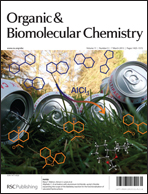Investigation on the 1,6-naphthyridine motif: discovery and SAR study of 1H-imidazo[4,5-h][1,6]naphthyridin-2(3H)-one-based c-Met kinase inhibitors
Abstract
The 1,6-naphthyridine motif is a multivalent scaffold in medicinal chemistry presenting various bioactivities when properly substituted. By incorporating a cyclic urea pharmacophore into the 1,6-naphthyridine framework through conformationally constraining the 7,8-positions, the resulting 1H-imidazo[4,5-h][1,6]naphthyridin-2(3H)-one was identified as a new class of c-Met kinase inhibitor. A comprehensive SAR study indicated that an N-1 alkyl substituent bearing a terminal free amino group, a hydrophobic substituted benzyl group at the N-3 position and the tricyclic core were essential for retaining effective Met inhibition of the 1H-imidazo[4,5-h][1,6]naphthyridin-2(3H)-one chemotype. Further introduction of a 4′-carboxamide phenoxy group at the C-5 position significantly improved the potency. The best c-Met kinase inhibitory activity was exemplified by 2t with an IC50 = 2.6 μM, which also displayed effective inhibition against TPR-Met phosphorylation and the proliferation of the BaF3-TPR-Met cells at low micromolar concentrations.
![Graphical abstract: Investigation on the 1,6-naphthyridine motif: discovery and SAR study of 1H-imidazo[4,5-h][1,6]naphthyridin-2(3H)-one-based c-Met kinase inhibitors](/en/Image/Get?imageInfo.ImageType=GA&imageInfo.ImageIdentifier.ManuscriptID=C2OB26710A&imageInfo.ImageIdentifier.Year=2013)

 Please wait while we load your content...
Please wait while we load your content...